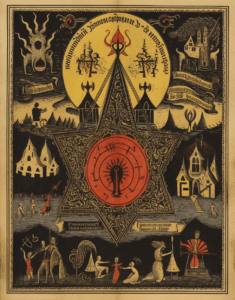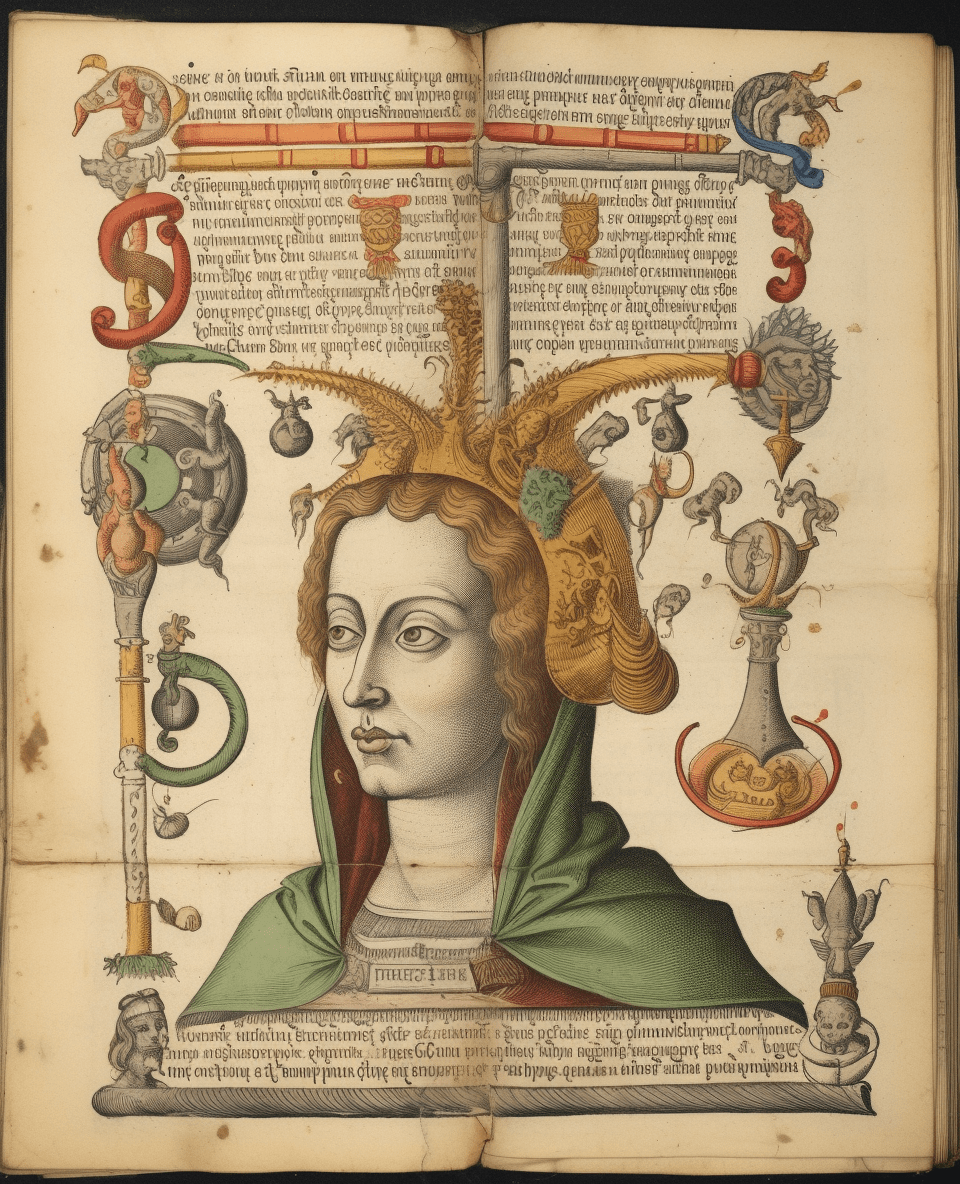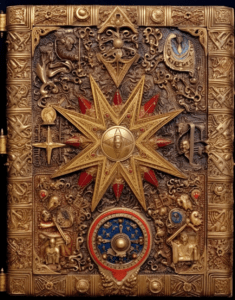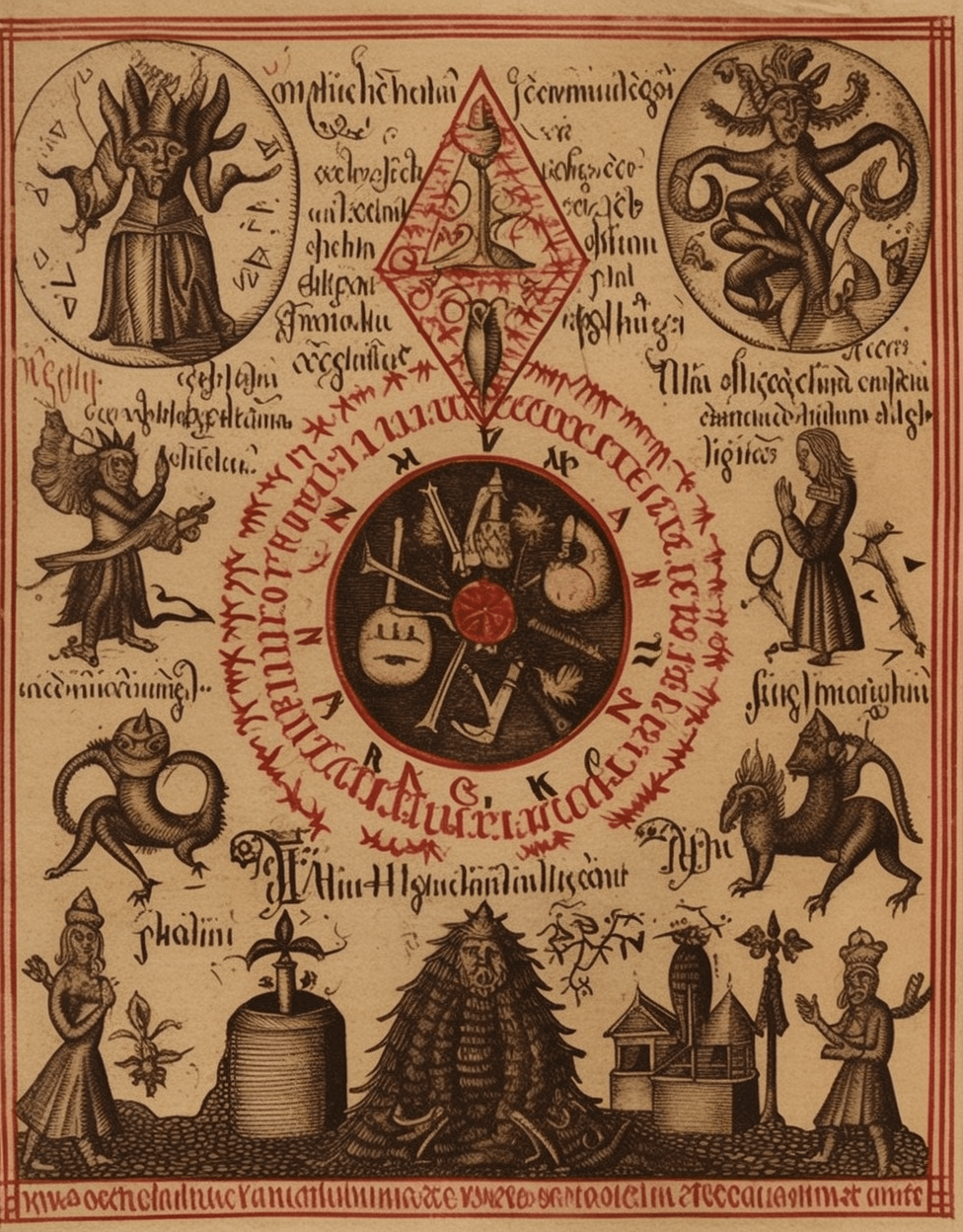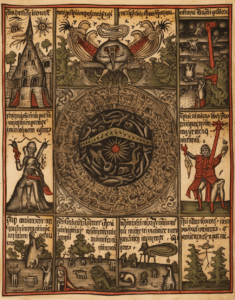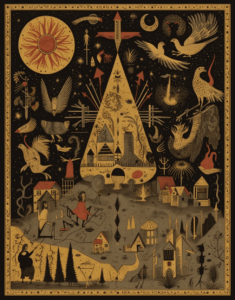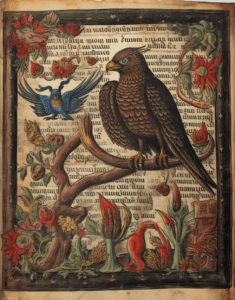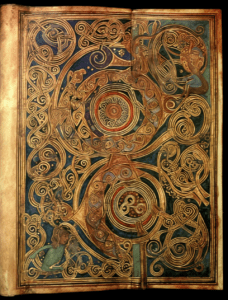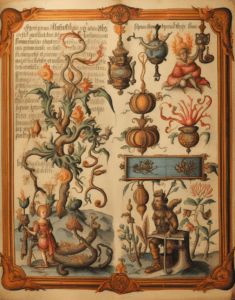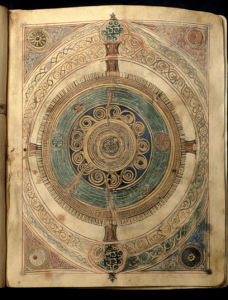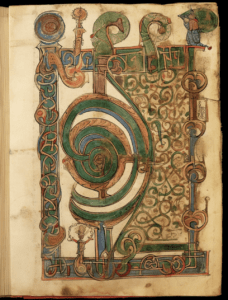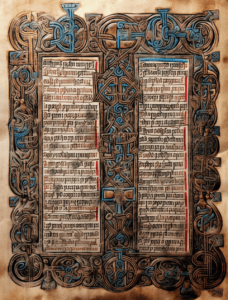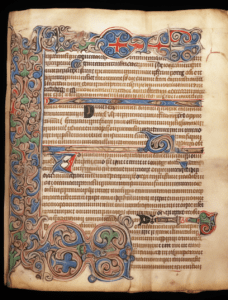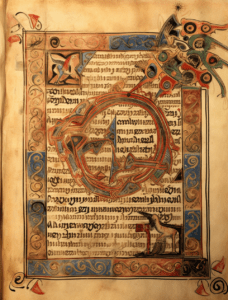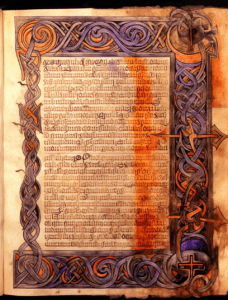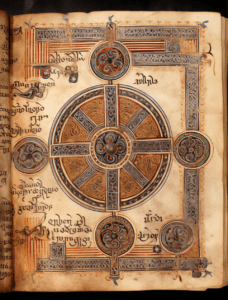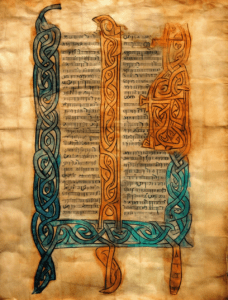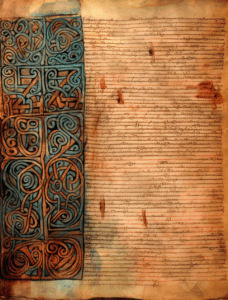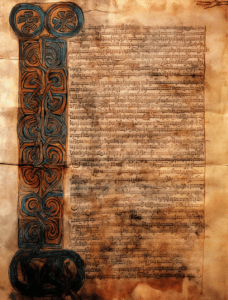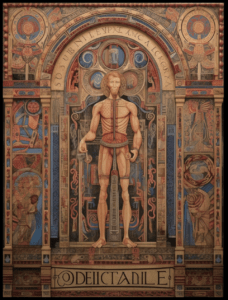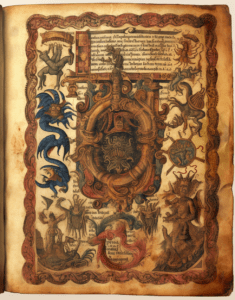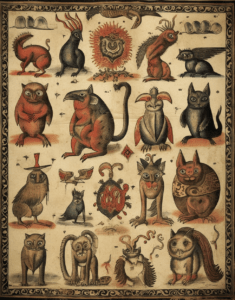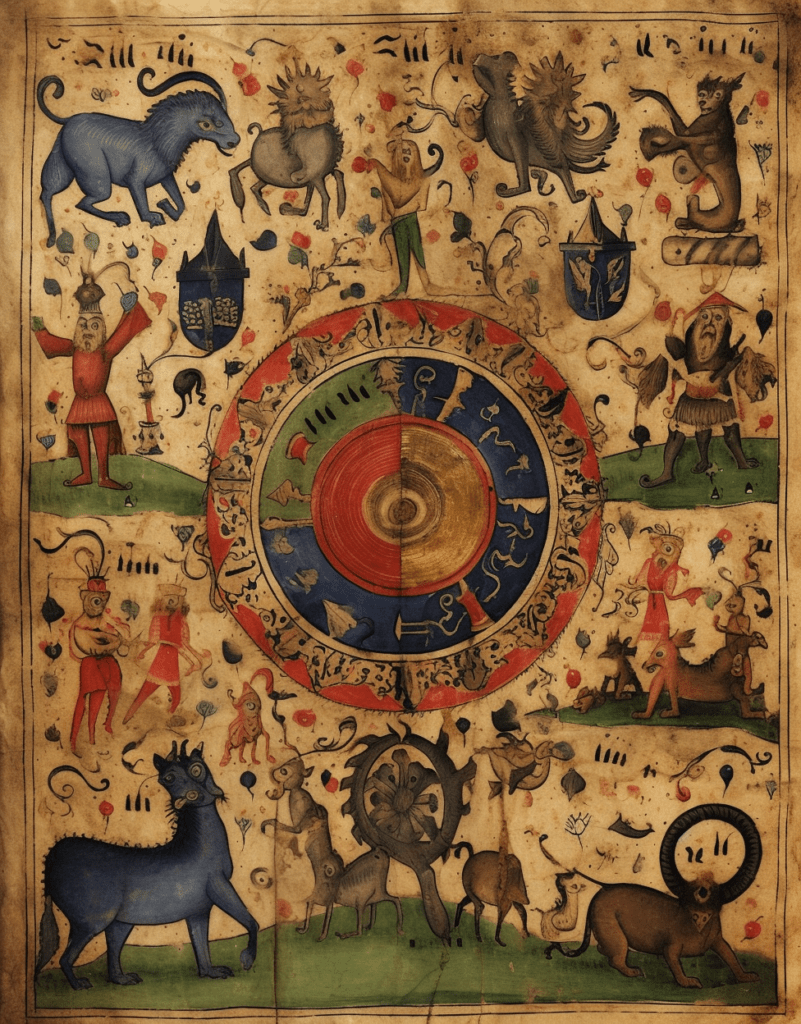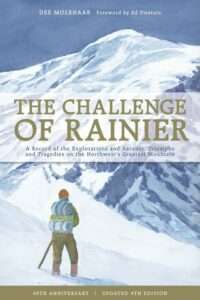Eerika’s Journal
**Entry One: The First Full Moon After the Longest Night of the Year**
The sky is lit bright by the first full moon following the longest night. The snow beneath my feet crunches, a symphony of solitude in the vast northern wilderness. I find solace in these mountains, in the silence that only the top of the world can offer. I am far from the clamor of the villages, the din of the mead halls. Here, it is just me, the wind, and the gods.
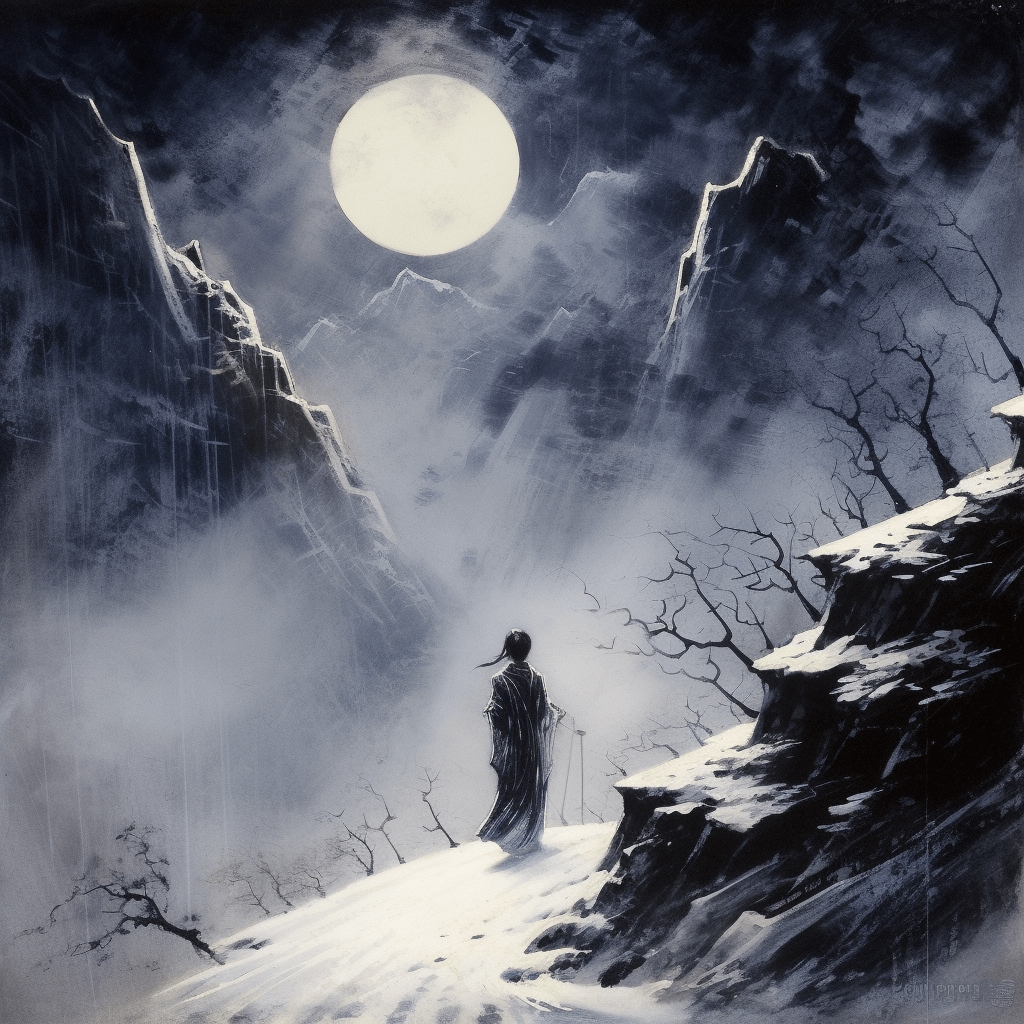
Entry Two: The First Thaw of Spring
The ice is beginning to yield to the soft whispers of spring. The once crisp and biting air now carries the scent of damp earth and budding life. I’ve begun my descent into the lower valleys, following the trails of the deer and the call of the rivers. The mountains have taught me well this winter, their snowy peaks and frozen lakes as challenging as they are beautiful.
Entry Three: When the Mountains Bloom
The mountainsides are ablaze with the colors of spring. Flowers of every hue have claimed their space between the rocks, dotting the green with their vibrant blooms. I find myself pausing more often, drinking in the beauty around me, the peace it brings. But the mountains are not just about serenity, they are about survival, about strength, and I am reminded of this every time I push through a hard climb or navigate a treacherous path.
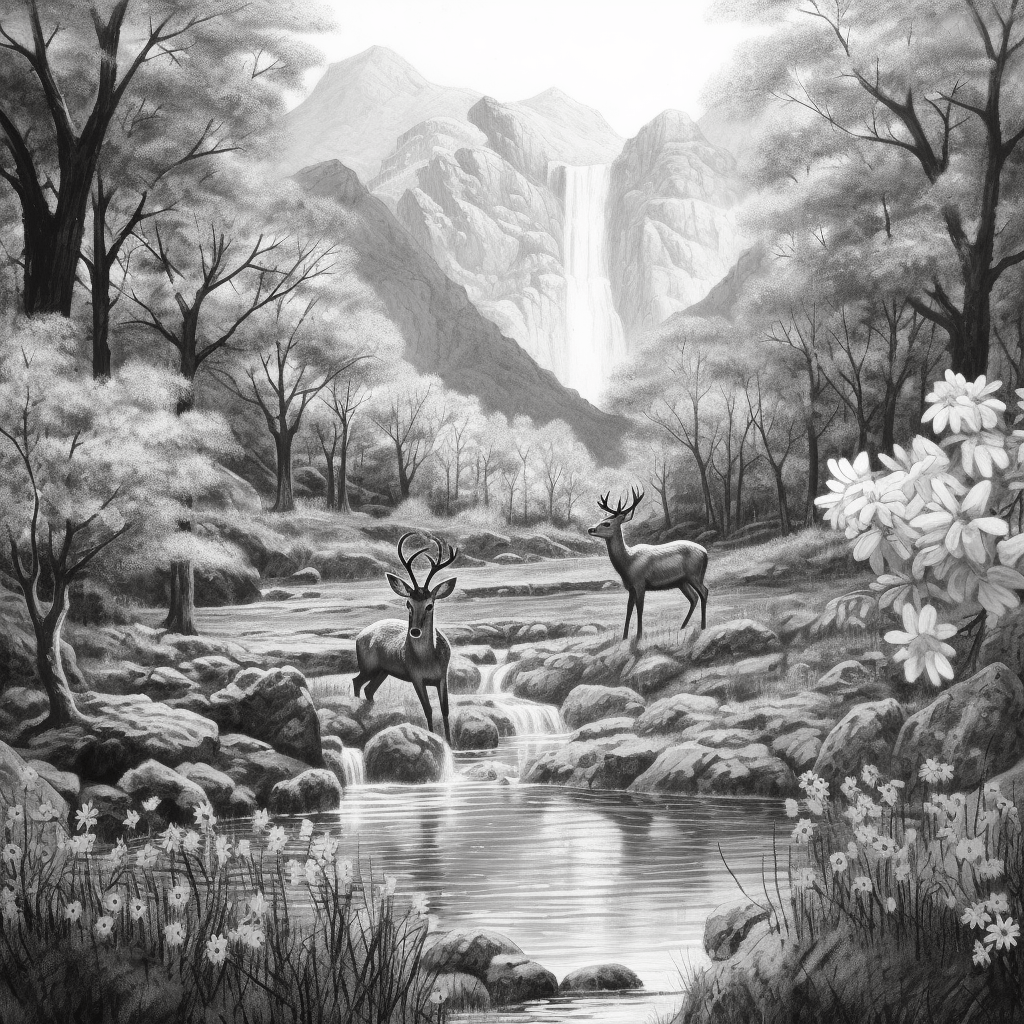
Entry Four: The Arrival of the Midnight Sun
Summer has come, and with it, the midnight sun. There is a strange beauty in witnessing the sun at midnight, its golden light bathing the mountains in an otherworldly glow. The paths are more accessible now, the mountain’s icy guard has withdrawn, yet new challenges present themselves. Every step, every ascent is a dance with danger, but I would not trade it for the safety of the village. This is my life, my freedom.
Entry Five: The Night of the First Autumn Storm
The first storm of autumn has descended upon the mountains. The air is ripe with the scent of wet foliage, the once distant rumble of thunder now a constant companion. The change in weather brings a different rhythm to life, a different melody to the song of the mountains. It’s a dance of adaptation, of resilience. I take shelter under an overhang, the fire I’ve kindled a beacon of warmth against the cold.
Entry Six: On the Eve of the Winter Solstice
Winter is at our doorstep again. The mountains are preparing for their long sleep, their vibrant colors fading into white. I too am preparing, gathering firewood, drying meat, marking trails. The coming months will be hard, the mountains unforgiving. But, as the cold winds begin to howl, I can’t help but feel a sense of anticipation. For in the heart of the winter, under the cloak of the Northern Lights, I will find my solitude, my peace, my strength. And when the first full moon after the longest night graces the sky again, I will be ready for another year in the embrace of these ancient mountains.
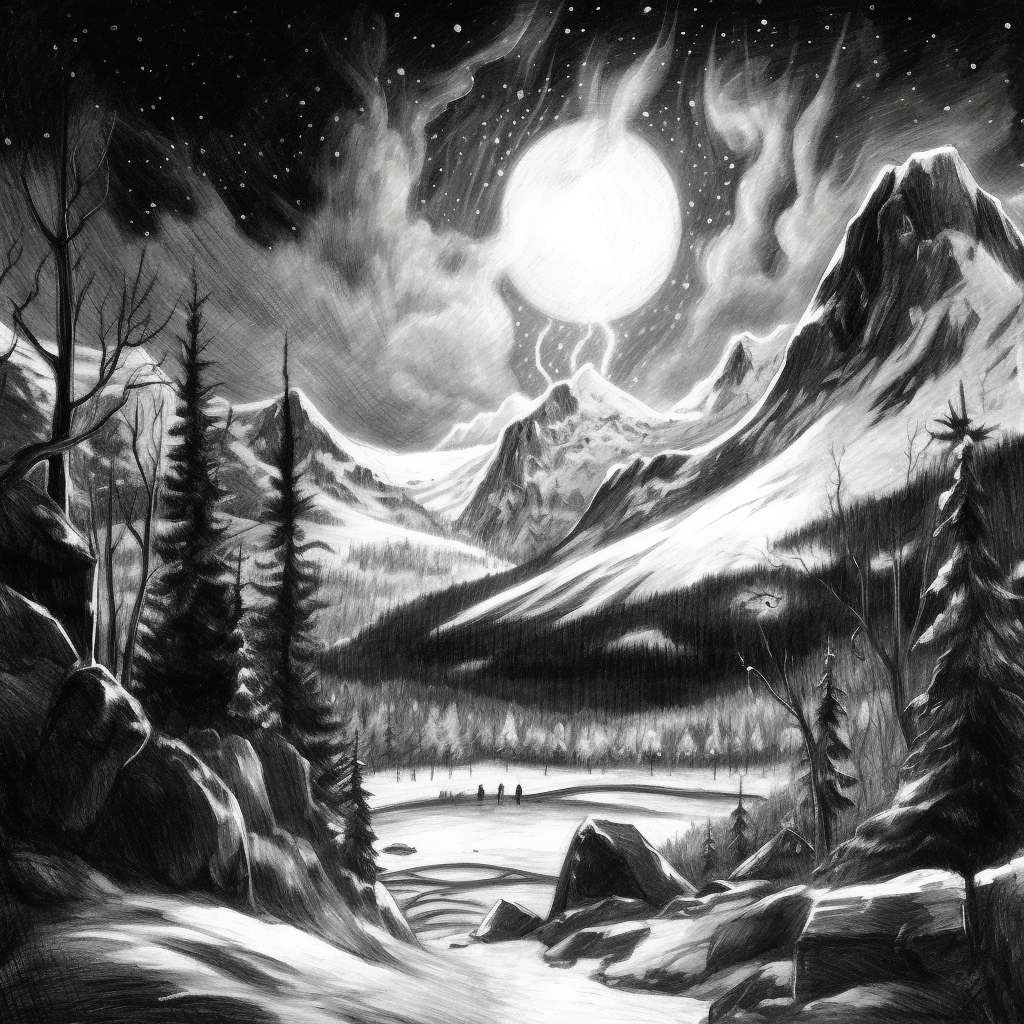
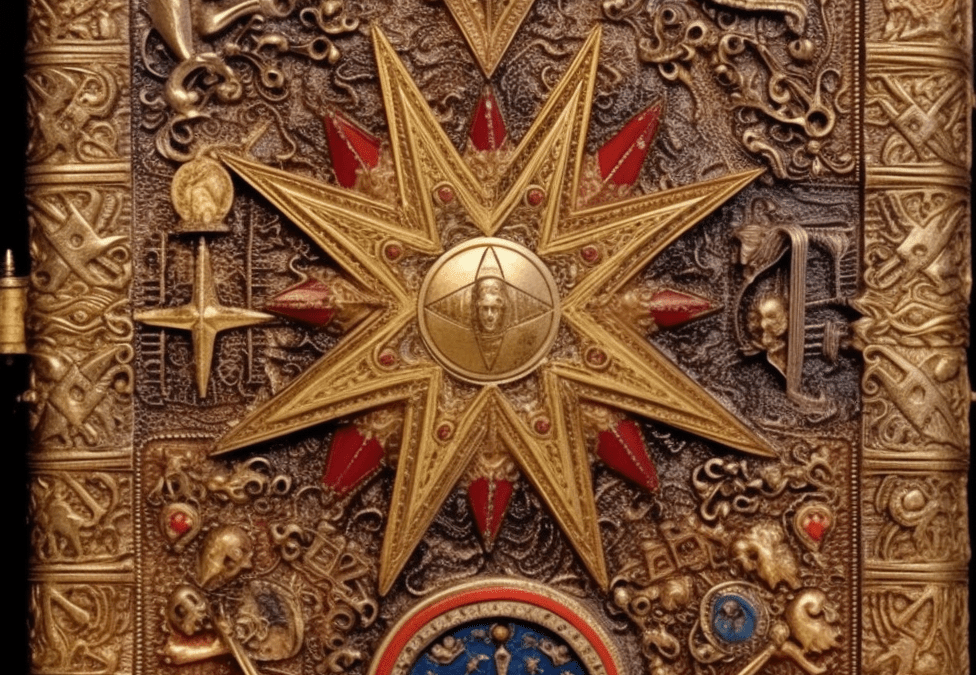
The Frozen Viking Mountaineers and the Book of Varghild
The Frozen Viking Mountaineers and the Book of Varghild
The Team
In the early years of the Viking Age, Fritjof, Halvar, Eerika, Fritjof roamed across the mountains of Scandinavia, exploring its rugged terrain and hidden valleys, and journeying to distant lands, including Ireland, England, and France. These daring raids brought them not just treasures of gold and silver, but also a wealth of knowledge and stories from the far corners of the known world.
During one of their excursions in Ireland, they stumbled upon an ancient abbey, its stone walls weathered by time and its halls abandoned. As they explored its depths, they found an ornate chest hidden within a secret chamber. Carefully opening it, they revealed an object of immense beauty and mystery — a book.
This book, much like the famed Book of Kells, was an illuminated manuscript of incredible intricacy. It was crafted from fine vellum, its pages filled with a still unknown text and ornate illustrations that were a riot of color and detail, intertwining human, animal, and mythical forms. The book was teeming with intricate knotwork and interlacing patterns that seemed to dance and sway across each page. The four adventurers were left breathless by the magnitude of the work before them, its detail, and the skill required to produce such a magnificent piece.
The illustrations contained the strangest figures of poeple, animals, monsters and demons, the history of some unknown world weaved into its art. Yet, unlike the Book of Kells, this manuscript hardly contained anything recognizable. A thousand years later scholars still have no idea what exactly is on the pages.
As Eerika, who was adept in the runic arts, studied the book, she began to understand that it was more than a simple work art. It was a codex, a guide to something greater. Each symbol, every knotwork, and all the interlaced patterns were a part of an elaborate map leading to a sacred artifact.
Compelled by this revelation, the four adventurers set out on a new quest. Guided by the book, they traversed the lands, sailed the seas, and delved into the deepest caves. The journey was fraught with danger, but their resolve never wavered.
In the end, they found the sacred artifact, a powerful relic from the time when the Norse gods walked among men. It was a thrilling adventure, a tale of discovery and unity, a testament to the enduring spirit of exploration that bound Fritjof, Halvar, Eerika, and Olaf together. Their tale lives on, whispered in the wind that sweeps across the Scandinavian mountains, echoing in the tales told by the skalds, and forever immortalized in the pages of their precious book, a testament to their adventures and their indomitable spirit.
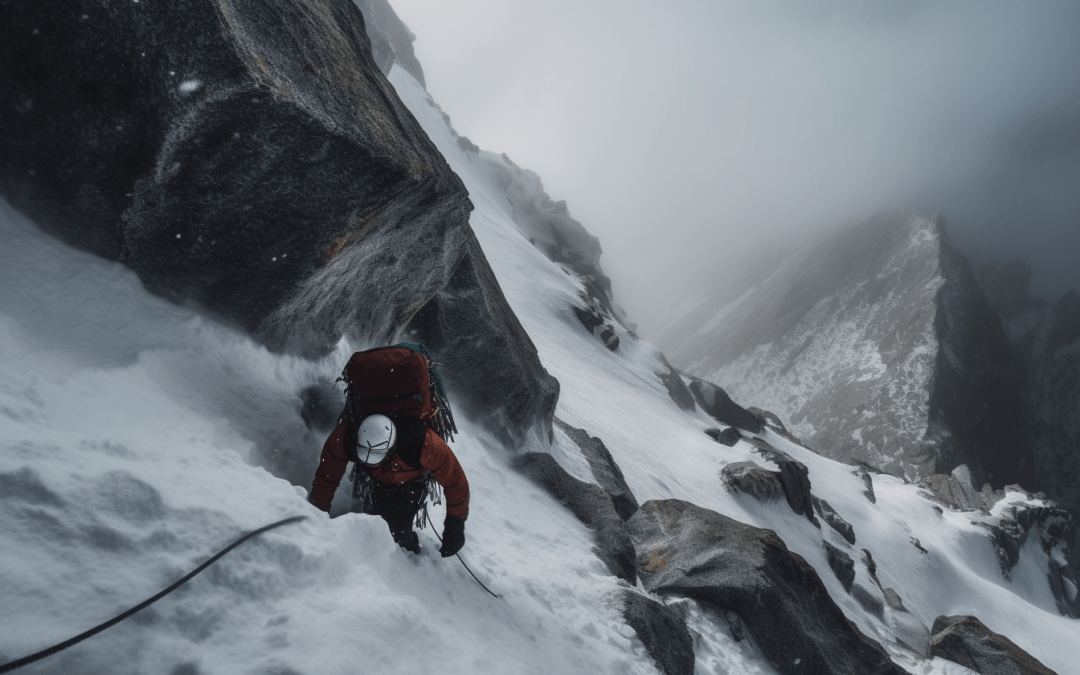
New Routes up Galdhøpiggen in Jotunheimen National Park
On April 5th, 2023, Fritjof and Halvar climbed two new routes in Jotunheimen National Park. They skied into the area on April 4th, expecting three good days of weather after their arrival. The first route they established was on the previously unclimbed Northwest Face of Galdhøpiggen, which they named the Borealis Face. The second route was on an unnamed peak south of Galdhøpiggen, and the route they established was called the Agaric Couloir.
To climb the Borealis Face, Fritjof and Halvar skied to the base of the route from camp and used snow pickets to surmount the short-lived yet overhung Bergshrund. They cached their skis and simul-soloed the first half of their route, chasing the best ice runnels. The second half of the route was simul-climbed as the climbing became steeper and more exposed. During their climb, they were spotted by Frank Peterson, who was flying clients on a scenic flight. Peterson circled over Fritjof and Halvar and took photos.
The descent of the Borealis Face took almost as long as the ascent due to the amount of searching and digging required to find good rappel anchors in the rock. Fritjof and Halvar climbed the route in approximately 4 hours. In 1966, David Roberts, Arthur Davidson, David Johnston, Pete Meisler, and Richard Millikan likely were aiming for this face based on the location of their advanced basecamp, but poor weather kept them from making an attempt. The face is hard to see from almost anywhere in the Jotunheimen most traveled areas.
The following day, Fritjof and Halvar climbed the Agaric Couloir. They started in the afternoon for safer conditions and simul-soloed the first portion of the route. As the climbing got harder, they pitched out the route, beginning with an ice hose in a corner with a few mixed moves at the exit. The real crux of the route was a chockstone, which required an extensive amount of snow-shoveling/clearing to get to the rock. It required a few creative aid moves and an exciting mixed exit. Fritjof and Halvar completed their climb in 9 hours and were gifted with an incredible sunset. They descended quickly with abundant rock anchors.

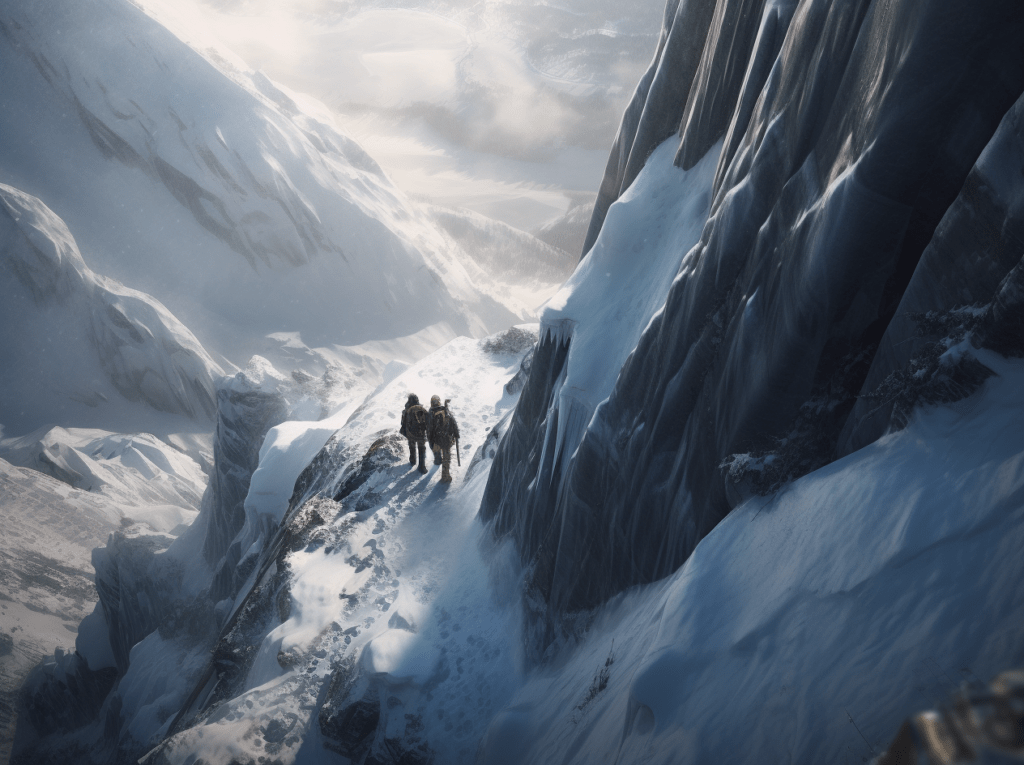


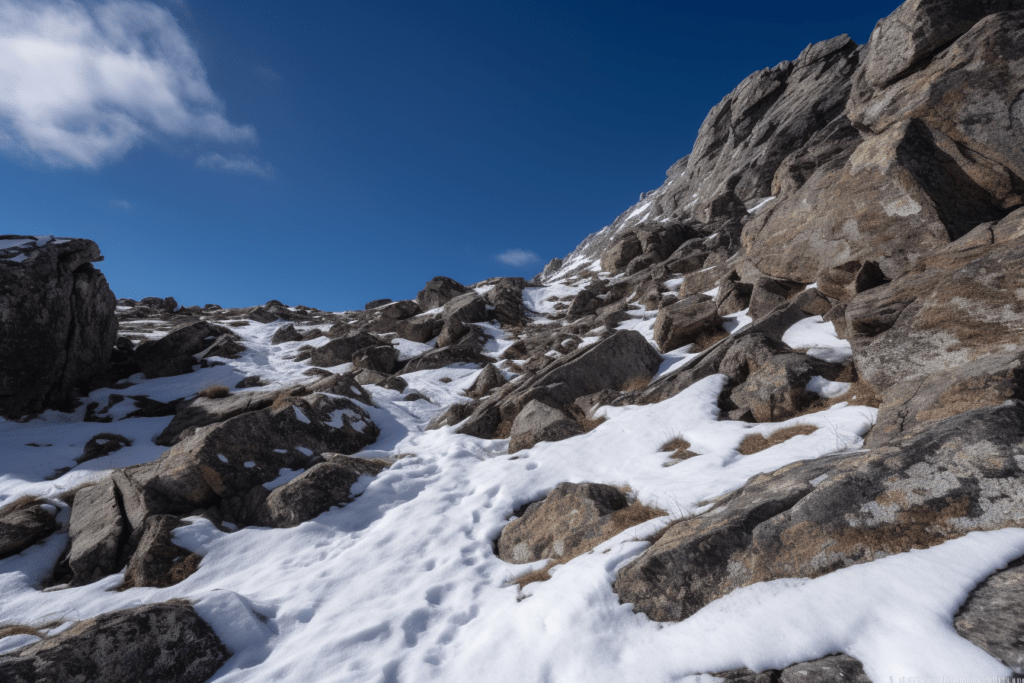
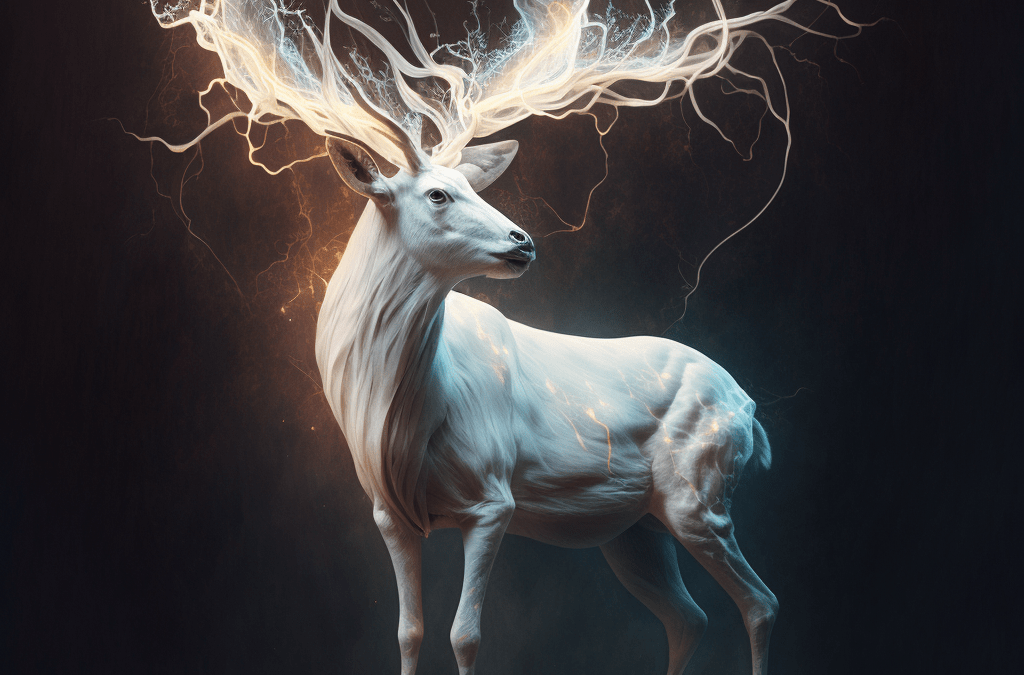
Fritjof and Halvar vs the Stag
Fritjof and Halvar, two legendary warriors and hunters, were deep in the forest on a hunt for game. As they stalked through the underbrush, they began to argue about who was the greater hunter.
Fritjof, tall and muscular, boasted of his ability to take down even the fiercest beasts with ease. “I am the greatest hunter,” he declared, “my aim is true and my strength unmatched. No animal can escape my grasp.”
Halvar, shorter but equally muscular, scoffed at Fritjof’s claims. “You may be strong,” he said, “but strength alone does not make a great hunter. It takes skill, cunning, and patience to truly master the hunt. And in those qualities, I surpass even you, Fritjof.”
The two warriors continued to argue, their voices growing louder and more heated. Suddenly, they heard a rustling in the bushes nearby. Fritjof drew his bow, ready to take down whatever beast lay hidden in the underbrush.
But as the animal emerged, they both froze in surprise. It was a magnificent stag, with antlers like the branches of a great tree and fur as white as snow. The creature stood still for a moment, regarding the two hunters with its dark, intelligent eyes.
In that moment, Fritjof and Halvar realized that they were both wrong. It was not their strength, nor their skill, nor their cunning that made them great hunters. It was their reverence for the natural world and the animals that inhabited it.
Without a word, the two warriors lowered their weapons and watched as the stag bounded away into the forest. As they made their way back to their village, they walked side by side in silence, their arguments forgotten.
For Fritjof and Halvar, the greatest lesson of the hunt was not about who was the better hunter, but about the importance of humility and respect in the face of the majesty of nature.
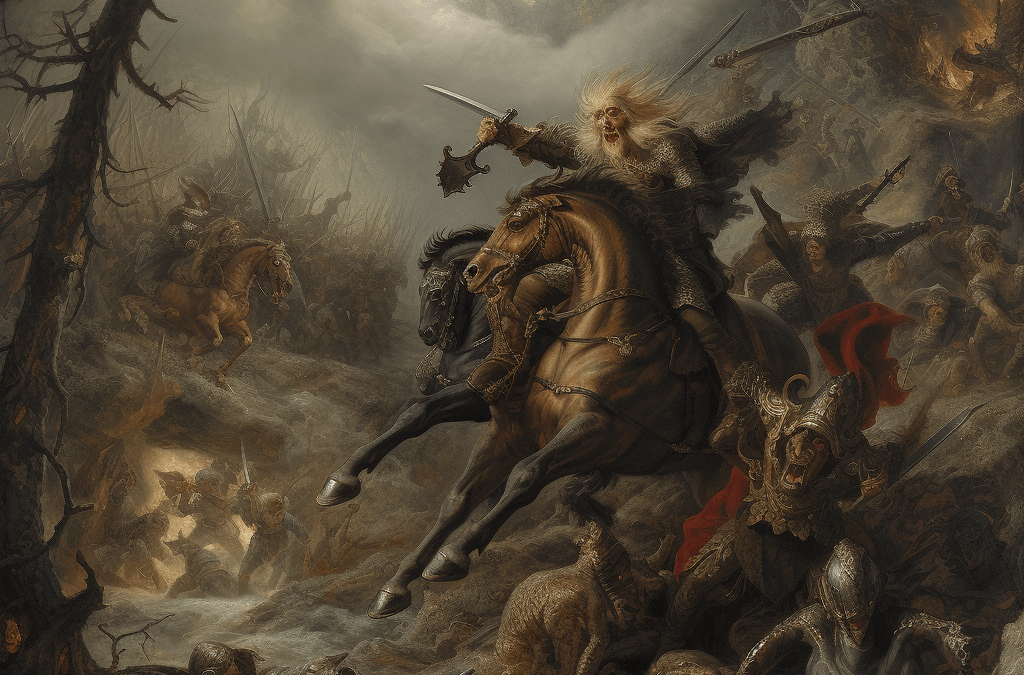
The Wild Hunt and the Frozen Viking Mountaineers
The Wild Hunt is a mythological phenomenon that has its roots in European folklore. It is a supernatural event that is said to occur when a group of spectral hunters or warriors ride across the night sky. The hunters are often accompanied by a pack of spectral hounds or otherworldly creatures.
The legend of the Wild Hunt has many variations, depending on the region and the culture in which it originated. In some versions, the hunters are led by a deity, such as Odin or Herne the Hunter, and are said to be searching for lost souls or otherworldly prey. In other versions, the hunt is said to be a foreboding omen of war, famine, or death.

The Wild Hunt of Odin – Peter Nicolai Arbo
According to some traditions, witnessing the Wild Hunt can be dangerous, as the hunters may mistake mortals for their prey and take them along on their ride. In other versions, the hunt is said to be a harbinger of good luck or a sign of fertility and abundance.
The Wild Hunt has been depicted in numerous works of art and literature, from medieval tapestries to contemporary fantasy novels. It continues to capture the imagination of people around the world, offering a glimpse into the mysterious and otherworldly realm of European folklore.
Hypothesis:
The Frozen Viking Mountaineers, namely Halvar, Eerika, Iona, and Fritjof, are the spectral hunters that ride across the night sky, known as the Wild Hunt. Based on the legends and folklore surrounding the Wild Hunt, it is plausible that the Mountaineers are the embodiment of the mythological hunters.
Evidence:
- The Mountaineers’ connection to ancient Viking culture: The Vikings were known for their seafaring and exploratory nature, often venturing into unknown territories in search of new lands and resources. The Mountaineers’ affiliation with Viking culture suggests that they have a similar adventurous spirit, which could manifest in the form of the Wild Hunt.
- The Mountaineers’ mysterious origins: Little is known about the Mountaineers’ origins or background, which could add to their mystical and supernatural appeal. The idea that they are the Wild Hunt could explain their otherworldly nature and strange abilities.
- The Mountaineers’ physical abilities: The Mountaineers are described as skilled climbers, hunters, and survivalists, with exceptional physical strength and endurance. These attributes could translate to their ability to ride across the night sky as spectral hunters.
- The Mountaineers’ connection to the mountains: The Wild Hunt is often associated with mountainous regions, where the hunters are said to ride across the night sky. The Mountaineers’ expertise in mountaineering and their connection to the mountains could be further evidence of their connection to the Wild Hunt.
Conclusion:
In conclusion, while there is no concrete evidence to support the hypothesis that the Frozen Viking Mountaineers are the spectral hunters of the Wild Hunt, there are several factors that suggest a possible connection between the two. Based on their affiliation with Viking culture, mysterious origins, physical abilities, and connection to the mountains, it is plausible that the Mountaineers are the embodiment of the mythological hunters. Further research and exploration of the Mountaineers’ history and folklore could help shed more light on this fascinating hypothesis.
Halvar Rescues Eerika
Halvar, a fearless Frozen Viking Mountaineer, was on a quest to find his friend Eerika who had disappeared while on a journey through the mud flats and villages of North Frisia. He had heard rumors that she had been taken captive by a group of raiders, and he was determined to rescue her at any cost.
Halvar traveled across the rugged terrain, enduring harsh weather conditions and battling fierce foes along the way. He fought off hordes of barbarians and outsmarted cunning thieves, all the while searching for any sign of Eerika’s whereabouts.
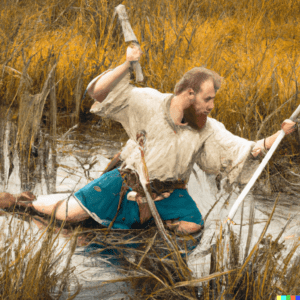
As he journeyed through the villages, Halvar listened closely to the whispers of the locals, hoping to gather any information that might lead him to Eerika. He learned of a powerful chieftain who had taken control of the region and was known for his ruthless tactics.
Determined to find Eerika, Halvar disguised himself as a trader and made his way to the chieftain’s stronghold. He offered the chieftain rare and valuable goods, hoping to gain his trust and earn a place among his followers.
Over time, Halvar learned the chieftain’s secrets and discovered the location of Eerika’s imprisonment. He waited for the opportune moment to strike, and when it finally came, he launched a surprise attack on the chieftain’s stronghold.
Halvar fought valiantly, battling the chieftain and his warriors with his sword and shield. In the end, he emerged victorious, freeing Eerika from her captivity and bringing her back to safety.
Best Mountaineering Books
“Mountains of the Mind” by Robert Macfarlane is a non-fiction book that explores the history, culture, and psychology of mountains and mountaineering. Macfarlane discusses the ways in which mountains have been perceived and represented in art, literature, and popular culture, and how our relationship with them has changed over time. He also delves into the dangers and allure of climbing, and the impact that mountaineering has had on the landscape and on mountaineers themselves.
Fallen Giants: A History of Himalayan Mountaineering
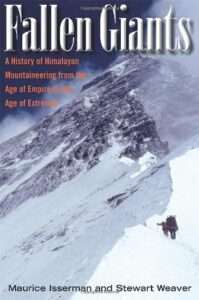
“Fallen Giants: A History of Himalayan Mountaineering” is a book by British mountaineer and historian Maurice Isserman. The book provides an in-depth historical account of the development of mountaineering in the Himalayas, covering significant expeditions and mountaineers from the late 19th century to the present day.
Isserman examines the political, social, and cultural context in which mountaineering developed in the region, and the impact of mountaineering on the people and environment of the Himalayas. The book also explores the risks and challenges of high-altitude mountaineering, as well as the controversies surrounding the commercialization of mountaineering in the region.
Overall, “Fallen Giants” is a comprehensive and engaging account of the history of Himalayan mountaineering, and provides valuable insights into the complex relationship between humans and the world’s highest mountains.
The World Beneath Their Feet: Mountaineering, Madness, and the Deadly Race to Summit the Himalayas
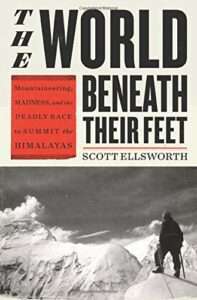
“The World Beneath Their Feet: Mountaineering, Madness, and the Deadly Race to Summit the Himalayas” is a book by New York Times bestselling author Scott Ellsworth. The book tells the story of the race to climb the world’s highest mountains, with a particular focus on the intense competition between British and American climbers in the mid-20th century.
Ellsworth explores the motivations and personalities of the climbers involved, including George Mallory, who famously disappeared on Mount Everest in 1924, and the American climbers who competed with the British for mountaineering supremacy. The book also delves into the psychological and physical toll of high-altitude climbing, including the effects of oxygen deprivation and extreme weather.
Overall, “The World Beneath Their Feet” provides a gripping and insightful account of the history of mountaineering in the Himalayas, as well as the risks and rewards of pursuing the ultimate mountaineering challenge: reaching the summit of Mount Everest.
Fifty Percent of Mountaineering is Uphill

“Fifty Percent of Mountaineering is Uphill” is a book written by British mountaineer and author, Felicity Aston. The book is a memoir of Aston’s experiences while participating in the first all-female team to ski across Antarctica.
In the book, Aston details her journey from being an ordinary person to becoming a seasoned explorer. She discusses the physical and mental challenges that she and her teammates faced during their expedition, including the harsh Antarctic weather conditions and the strain that such a journey can place on a person’s body and mind.
Aston also reflects on the lessons she learned during her journey, such as the importance of perseverance, team collaboration, and positive thinking. The book provides insights into the world of mountaineering and the difficulties and triumphs that come with it.
Overall, “Fifty Percent of Mountaineering is Uphill” is an inspiring and engaging read that will appeal to anyone interested in adventure, exploration, and personal growth.
Memoirs of a Dinosaur Mountaineer

“Memoirs of a Dinosaur Mountaineer” is a memoir by the American mountaineer, scientist, and writer Kelly Cordes. It was published in 2021 and tells the story of his adventures in mountaineering and his work as a geologist and dinosaur tracker in the American West. The book received positive reviews for its combination of outdoor adventure, science, and personal reflections.
“The Challenge of Rainier: A Record of the Explorations and Ascents, Triumphs and Tragedies, on the Northwest’s Greatest Mountain” written by Dee Molenaar. It was first published in 1971 and provides an account of the history of mountaineering on Mount Rainier, the highest peak in the Cascade Range of Washington State, USA. The book covers the first recorded ascent of the mountain in 1870 and the subsequent mountaineering expeditions, including triumphs and tragedies. Molenaar, a noted mountaineer and artist, was involved in many of the ascents on Mount Rainier and provided detailed illustrations for the book. It is considered a classic in mountaineering literature and provides valuable insights into the challenges of climbing one of North America’s iconic peaks.
Ways to the Sky: A Historical Guide to North American Mountaineering

“Ways to the Sky: A Historical Guide to North American Mountaineering” is a comprehensive guide to the history of mountaineering in North America. It was written by Andy Selters and published in 2004.
The book covers the major peaks and ranges in North America, including the Rockies, the Sierra Nevada, the Cascades, and the Alaska Range, as well as lesser-known areas such as the Appalachian Mountains and the Mexican Volcanoes. Each section includes a history of the first ascents and significant climbs, as well as detailed information on the routes and challenges of each peak or range.
In addition to covering the technical aspects of mountaineering, the book also provides insight into the cultural and social context of climbing in North America. It includes profiles of notable climbers and their achievements, as well as discussions of the environmental and ethical issues surrounding mountaineering.
“Ways to the Sky” is a valuable resource for anyone interested in the history of mountaineering in North America, from beginner climbers to experienced alpinists. It provides a fascinating look into the evolution of mountaineering as a sport and its impact on the North American landscape.
“First Ascent” by Stephen Venables
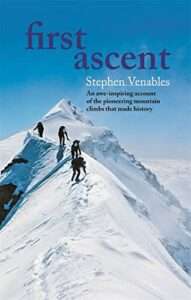
“First Ascent” is a book written by Stephen Venables, a British mountaineer, and writer. The book was published in 1991 and recounts Venables’ harrowing experience of climbing Mount Everest via a new route in 1988.
In “First Ascent,” Venables describes the challenges he faced while attempting to climb the highest mountain in the world via the West Ridge, a route that had never been climbed before. He describes the dangers of the route, including the steep and unstable terrain and the risk of avalanches. Venables also writes about the physical and mental challenges of climbing at high altitude, as well as the camaraderie and teamwork required for such an endeavor.
One of the most dramatic moments of the book is Venables’ solo descent from the summit of Everest, after he became separated from his climbing partner during a storm. The descent was a remarkable feat of endurance and survival, and Venables’ vivid description of the experience makes for compelling reading.
“First Ascent” is a gripping and inspiring account of one of the most challenging feats in mountaineering, written by a skilled storyteller who was intimately involved in the events he describes. The book is widely regarded as a classic of mountaineering literature and has been praised for its honesty, humility, and insight into the nature of adventure and exploration.
Tales of a Western Mountaineer
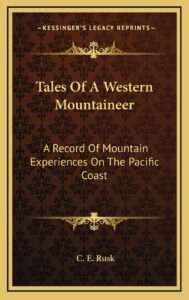
“Tales of a Western Mountaineer” is a book written by American mountaineer and author, Maurice Isserman. The book was published in 1982 and is a collection of essays and stories about Isserman’s experiences as a mountaineer in the western United States.
In the book, Isserman describes his early climbing experiences in the Cascade Mountains of Washington and Oregon, as well as his adventures in the Rocky Mountains, including the Tetons and the Wind River Range. He writes about his relationships with other climbers, the challenges of climbing at high altitude, and the thrill of reaching the summits of some of North America’s most iconic peaks.
“Tales of a Western Mountaineer” is not just a book about climbing, however. Isserman also reflects on the history and culture of the American West, and his essays touch on a wide range of topics, from Native American history to the environmental impact of climbing.
The book is notable for its engaging and vivid writing style, which captures the excitement and beauty of the mountain landscapes that Isserman has explored. “Tales of a Western Mountaineer” is a must-read for anyone interested in mountaineering, the American West, or simply good storytelling.
“Touching the Void” is a non-fiction book by Joe Simpson, published in 1988. It recounts the harrowing experience of Simpson and his climbing partner Simon Yates as they attempted to climb the west face of Siula Grande in the Peruvian Andes in 1985.
During their descent, Simpson suffered a severe leg injury, and Yates was forced to make the difficult decision to cut the rope connecting them in order to save his own life. Believing that Simpson had fallen to his death, Yates continued his descent, while Simpson was left alone and stranded on the mountain.
Despite his injuries, Simpson managed to crawl and hop his way back to base camp over several days, encountering numerous life-threatening obstacles along the way. His journey is a testament to his extraordinary will to survive and his remarkable courage in the face of extreme adversity.
The book has since become a classic of mountaineering literature, and has been adapted into a documentary film of the same name.
The Time Iona and Eerika met Baldr
Once upon a time, Iona, a Scottish mountaineer, and Eerika, a proud and fearless Viking woman, set out on a joint expedition to conquer a daunting mountain in the far north. As they climbed higher and higher, the air grew colder and the wind fiercer, but their determination never wavered.
As they reached the summit, they were met by a figure with a long beard and giant sword, who introduced himself as Baldr, the god of light and purity. Iona and Eerika were surprised but unafraid, as they were no strangers to encountering unexpected things on their mountain climbs.
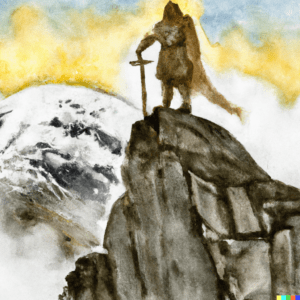
Baldr explained to them that he had been watching their ascent and was impressed by their strength and courage. He revealed that he had been sent by Odin to test their worthiness and to offer them a reward for their bravery.
Baldr offered Iona and Eerika a choice: they could either receive the gift of eternal life, or they could be granted one wish each. Iona and Eerika conferred with each other and decided that while eternal life would be tempting, they would prefer to have their wishes granted.
Iona wished for the ability to climb any mountain, no matter how challenging, with ease and grace. Eerika wished for a never-ending supply of strength and bravery to face any challenge that came her way.
Baldr was pleased with their choices and granted their wishes. As they began their descent, Iona and Eerika could feel the newfound strength and grace flowing through their bodies.
As they made their way down the mountain, they couldn’t help but feel grateful for their encounter with Baldr. They knew that their lives had been forever changed and that they would be able to conquer any mountain, physical or metaphorical, that came their way.
Askafroa the Guardian of the Ash Tree
Long ago, in a forest shrouded in mist and shadow, there lived a powerful tree nymph named Askafroa. She was charged with the protection of the ash trees that grew in that forest, and she took her duties very seriously. Askafroa was a stern and imposing figure, and her bark-like skin was tough and unyielding. But despite her fearsome reputation, she was respected by all who knew her.
One day, while patrolling the forest, Askafroa came across a group of Erklings, small elf-like creatures known for their high-pitched laughter. The Erklings were known to be mischievous and sometimes dangerous, but they were also loyal to those they deemed worthy. Askafroa recognized that the Erklings could be useful allies, and she decided to strike up a bargain with them.
“If you help me protect the ash trees, I will offer you my protection as well,” she said to them.

The Erklings agreed, and soon they were working together to keep the forest safe. Askafroa used her powers to control the growth of the trees, while the Erklings used their entrancing laughter to ward off intruders. Over time, the two groups grew to respect each other, and eventually, they even fell in love.
Askafroa and the Erklings were an unlikely match, but their love was strong and enduring. They ruled over the forest together, protecting it from all who would harm it. And even after many years had passed, their love never faded.
So if you ever find yourself wandering through a misty, shadowy forest, keep an eye out for Askafroa and the Erklings. They may be fearsome creatures, but their love and loyalty are truly remarkable.
Halvar and the Wind-Troll Ysätters-Kajsa
Halvar was a Viking mountaineer from the frozen north, who had spent most of his life scaling the icy peaks of the mountains. He was known far and wide for his fearless spirit, his incredible strength, and his ability to withstand the harshest of conditions.
One day, as Halvar was making his way through a treacherous mountain pass, he encountered a fierce wind that threatened to knock him off his feet. He struggled against the gusts, but they only grew stronger, whipping around him with a fury that threatened to tear him apart.

It was then that he heard a voice, a whisper on the wind, calling out to him. “Halvar,” it said, “you must seek out Ysätters-Kajsa. She is the mistress of the winds, and she alone can calm this storm.”
Halvar, never one to shy away from a challenge, set out to find Ysätters-Kajsa. He climbed higher and higher, through snow and ice, until he reached the very peak of the mountain.
There he found a small cave, and inside was Ysätters-Kajsa herself. She was a fearsome sight, with long, tangled hair that blew wildly in the wind, and eyes that glowed like embers.
Halvar approached her with caution, but he needn’t have worried. Ysätters-Kajsa welcomed him warmly, and listened as he explained his plight.
“The winds are too strong,” Halvar said. “They threaten to destroy everything in their path. Can you not calm them, Ysätters-Kajsa? Can you not spare us this destruction?”
Ysätters-Kajsa smiled, and reached out a hand to Halvar. “I can calm the winds,” she said. “But you must promise me something in return.”
“Anything,” Halvar said, without hesitation.
Ysätters-Kajsa’s eyes glinted in the darkness. “You must bring me a tribute,” she said. “A gift of something rare and precious. Only then will I calm the winds.”
Halvar thought for a moment. He had nothing of great value with him, nothing that could compare to the power of the winds.
But then he remembered something. He reached into his pack and pulled out a small, glittering gemstone. “This,” he said, holding it out to Ysätters-Kajsa. “It’s the only thing I have that’s truly rare and precious.”
Ysätters-Kajsa took the gemstone and studied it closely. Then she nodded, and closed her eyes. “The winds will calm,” she said. “But remember, Halvar. Everything has a price.”
Halvar didn’t know what Ysätters-Kajsa had meant about a price, but he couldn’t shake the feeling that he had made a grave mistake.
And he was right. When he returned to his village, he found that his people had been taken captive by a band of raiders, who had demanded a ransom of rare and precious gems in exchange for their release.
Halvar realized then that Ysätters-Kajsa had known all along what was coming, and had demanded the tribute as a way to protect herself. He had unwittingly brought a powerful tool into the hands of those who would use it for evil.
But Halvar was not one to give up easily. He rallied a group of his bravest comrades and set out to rescue his people. They battled fiercely against the raiders, and though the odds were against them, they fought with all their might.
In the end, they emerged victorious. The raiders were vanquished, and Halvar’s people were free once more.
But as they celebrated their triumph, Halvar couldn’t help but think about the price that he had paid. He had thought he was doing the right thing, seeking out Ysätters-Kajsa to calm the winds and save his people. But in doing so, he had inadvertently put them in even greater danger.
As he looked up at the sky, he saw that the winds had begun to stir once more. He knew then that he would have to be even more vigilant in the future, and that he could never let his guard down again.
For he had learned the hard way that sometimes, even the most well-intentioned actions can have unforeseen consequences. And that the winds of fate can be fickle and unpredictable, just like Ysätters-Kajsa herself.

